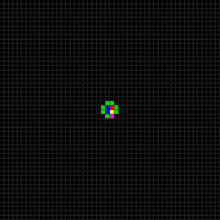Byl's loop

The Byl's loop is an artificial lifeform similar in concept to Langton's loop. It is a two-dimensional, 5-neighbor cellular automaton with 6 states per cell, and was developed in 1989 by John Byl, from the Department of Mathematical Sciences of Trinity Western University.
Details
The Byl's loop was developed just a few years after Langton's simplification of Codd's automaton, which produced a simpler automaton that would reproduce itself in 151 time-steps. John Byl simplified Langton's automaton further, with an even smaller automaton that reproduced in just 25 time-steps. Byl's automaton consisted of an array of 12 chips — of which 4 or 5 could be counted as the instruction tape — and 43 transition rules, while Langton's device consisted of some 10×15 chips, including an instruction tape of 33 chips, plus some 190 transition rules.
Essentially, the simplification consisted in using fewer cellular states (6 as compared with Langton's 8) and a smaller replicating loop (12 cells as compared with Langton's 86).
In 1989, John Byl devised a self-reproducing automata so small, twelve cells in six states with fifty-seven transition rules, that it undermines "von Neumann's 'complexity threshold' separating trivial from non-trivial self-replication" (Sigmund 1993:24[1]).
See also
References
- ^ Karl Sigmund (1995). Games of Life: Explorations in Ecology, Evolution and Behaviour. Penguin. p. 24. ISBN 0-14-024209-0.
Further reading
- John Byl (1989), "Self-Reproduction in Small Cellular Automata", Physica D, 34 (1–2): 295–299, Bibcode:1989PhyD...34..295B, doi:10.1016/0167-2789(89)90242-X
- John Byl (March 1989), "On Cellular Automata and the Origin of Life", Perspectives on Science and Christian Faith, 41 (1), American Scientific Affiliation: 26–29
External links
- visual representation of the Byl's loop in a Java applet
- Cellular Automata FAQ - Applications (section "What are Byl's rules for a self reproducing CA?") for the full rule set of Byl's loop
- Gianluca Tempesti (1998), "Chapter 3: Self-Replication", A Self-Repairing Multiplexer-Based FPGA Inspired by Biological Processes
